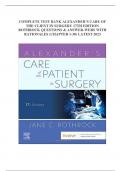Exam (elaborations)
ALEXANDER'S CARE OF THE PATIENT SURGERY 17TH EDITION ROTHROCK QUESTIONS & answersWITH RATIONALES (CHAPTER 1-30) LATEST 2023
- Course
- Institution
- Book
COMPLETE TEST BANK ALEXANDER’S CARE OF THE CLIENT IN SURGERY 17TH EDITION ROTHROCK QUESTIONS & answersWITH RATIONALES (CHAPTER 1-30) LATEST 2023 Table of Contents Unit 1: Foundations for Practice 1. Concepts Basic to Perioperative Nursing 2. Client Safety and Risk Management 3....
[Show more]



